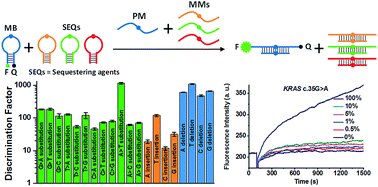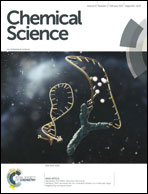Ultra-specific discrimination of single-nucleotide mutations using sequestration-assisted molecular beacons†
Abstract
Reliably distinguishing single-nucleotide mutations (SNMs) at low abundance is of great significance in clinical diagnosis. However, the specificity of most current SNM discrimination methods based on the Watson–Crick hybridization is seriously limited by the cross-reactivity of the probe with closely related unintended sequences. Herein, we propose a sequestration-assisted molecular beacon (MB) strategy for highly specific SNM discrimination. The new SNM discrimination system consists of a target-specific MB and a series of hairpin sequestering agents (SEQs). The rationally designed hairpin SEQs can effectively sequester the corresponding unintended sequences and thus dramatically improve the hybridization specificity of the MB in recognizing SNMs. The developed SNM discrimination method shows remarkably high specificity (discrimination factors ranging from 12 to 1144 with a median of 117) against 20 model SNMs, and can work rapidly and robustly over a wide range of conditions. Notably, our SNM discrimination method can be easily combined with PCR amplification for the detection of KRAS G12D (c.35G>A) and G12V (c.35G>T) mutations at abundance as low as 0.5%. This work expands the rule set of designing hybridization-based SNM discrimination strategies and shows promising potential application in clinical diagnosis.


 Please wait while we load your content...
Please wait while we load your content...